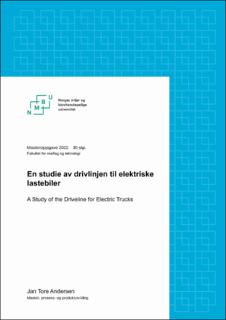| dc.contributor.advisor | Terjesen, Geir | |
| dc.contributor.author | Andersen, Jan Tore | |
| dc.date.accessioned | 2022-09-15T14:52:40Z | |
| dc.date.available | 2022-09-15T14:52:40Z | |
| dc.date.issued | 2022 | |
| dc.identifier.uri | https://hdl.handle.net/11250/3018131 | |
| dc.description.abstract | Fakultet for realfag og teknologi (REALTEK) ved Norges miljø- og biovitenskapelige universitet (NMBU) ønsket å øke kunnskapen om elektrifisering av tungtransport. Derfor ble denne masteroppgaven initiert våren 2022. Det var ønskelig å samle inn informasjon om ulike designløsninger, drivverksparametere og ytelsen til elektriske lastebiler. Elektrifiseringen av tungtransportbransjen er godt i gang og regjeringen i Norge har satt konkrete mål som omfatter elektrifiseringen. Produsentene konkurrerer om de beste løsningene. REALTEK ønsket informasjon om drivverket til elektriske lastebiler for å kunne modellere nye kjøretøy og verifisere eksisterende løsninger.
I oppgaven er det benyttet litteratursøk, informasjonsinnhenting fra ressurspersoner, estimeringer, beregninger og fysisk testing som metoder. Det har blitt opprettet kontakt med ressurspersoner i Scania og Volvo som har bidratt med informasjon om sine respektive kjøretøy. I hovedsak er det Scania P25 og Volvo FL Electric som er studert i denne oppgaven. Det er innhentet og estimert kjøretøysparametere for begge kjøretøyene. I tillegg er det hentet inn informasjon om ulike designløsninger for drivverket i elektriske lastebiler. Det er utført praktisk testing av Scania P25 for å verifisere beregningene som er utført. Beregnet akselerasjon fra 0-80 km/t var 21,4s, praktisk testing ga en gjennomsnittstid på 21,9s. Dette tyder på at beregningene og estimeringene som er gjort er fornuftige.
Elektriske motorer er mindre og har annerledes momentkarakteristikk og turtallsområde enn dieselmotorer, noe som gjør andre designvalg aktuelle. Fem ulike drivverkskonfigurasjoner er presentert i denne oppgaven. De ulike løsningene utforsker ulike måter å overføre den mekaniske energien fra motoren til drivhjulene. Den løsningen som Scania og Volvo har benyttet i sine elektriske lastebiler består av en elektrisk motor av typen permanentmagnetsynkronmotor som er montert under kjøretøyet. Fordelen med denne typen elektrisk motor er at den kan levere høyt dreiemoment ved lavt turtall, noe som er svært gunstig i et tungt kjøretøy som ikke behøver høy topphastighet. Motoren er i begge tilfellene koblet direkte til en totrinns girkasse. Videre overføres kraften via en mellomaksel, differensial og stikkakslinger til drivhjulene. Som resultat av litteraturstudiet er det to kilder som peker seg ut som svært nyttige:
- Artikkelen Influence of powertrain Topology and Electric Machine Design on Efficiency of Battery Electric Trucks – A Simulative Case Study av Sebastian Wolff m.fl. [1]
- Boken Heavy-Duty Electric Vehicles av Shashank Arora m.fl. [2] | en_US |
| dc.description.abstract | Faculty of Science and Technology (REALTEK) at the Norwegian University of Life Sciences (NMBU) had a wish to improve the knowledge about the electrification of heavy vehicles. That is why this master’s thesis was initiated by REALTEK in the spring of 2022. It was desirable to gather information on various design solutions, powertrain parameters and the performance of electric trucks. The electrification of the heavy haulage industry is on its way. The government in Norway have defined clear goals for this electrification process. The truck producers are competing to produce the best solutions. REALTEK wants more knowledge on this topic to model new vehicles and to verify existing solutions.
This thesis uses literature search, information gathering from resource persons, estimations, calculations, and physical testing as methods. Resource persons in Scania and Volvo helped collecting information about their respective vehicles. Mainly the Scania P25 and the Volvo FL Electric was studied in this report. Drivetrain parameters for both vehicles were collected. In addition, the information about different drivetrain topologies was presented. Practical testing of the Scania P25 was carried out. The estimated acceleration from zero to 80 km/h was 21,4s, and the measured mean acceleration was 21,9s. This means that the calculations and estimations conducted during the report is reasonable.
Electric motors are smaller and have different moment characteristics and area of speed than diesel engines, this makes new design choices available. Five different topologies were presented in this report. The different topologies explore different ways to transfer the mechanical energy from the motor to the drive wheels. Both Scania and Volvo used the same configuration in their electric trucks. The electric motor used in both trucks was a permanent magnet synchronous motor (PMSM) mounted directly under the vehicle. The PMSM is well suited for the heavy electric trucks because it can deliver high torque at low speeds. This is perfect for the trucks not needing a high maximum speed. The PMSM is directly connected to a two-speed gearbox. Then the differential is connected to the gearbox by a prop shaft, and then from the differential to the wheels by the axle shafts. As a result of the literature study two sources stand out to be the most useful:
- The article Influence of powertrain Topology and Electric Machine Design on Efficiency of Battery Electric Trucks – A Simulative Case Study by Sebastian Wolff et.al. [1]
- The book Heavy-Duty Electric Vehicles by Shashank Arora et.al. [2] | en_US |
| dc.language.iso | nob | en_US |
| dc.publisher | Norwegian University of Life Sciences, Ås | en_US |
| dc.rights | Attribution-NonCommercial-NoDerivatives 4.0 Internasjonal | * |
| dc.rights.uri | http://creativecommons.org/licenses/by-nc-nd/4.0/deed.no | * |
| dc.subject | Elektriske lastebiler | en_US |
| dc.subject | Drivverksparametere | en_US |
| dc.subject | Drivlinjer | en_US |
| dc.subject | Electric trucks | en_US |
| dc.subject | Drivetrain parameters | en_US |
| dc.title | En studie av drivlinjen til elektriske lastebiler | en_US |
| dc.title.alternative | A study of the driveline for electric trucks | en_US |
| dc.type | Master thesis | en_US |
| dc.description.localcode | M-MPP | en_US |

